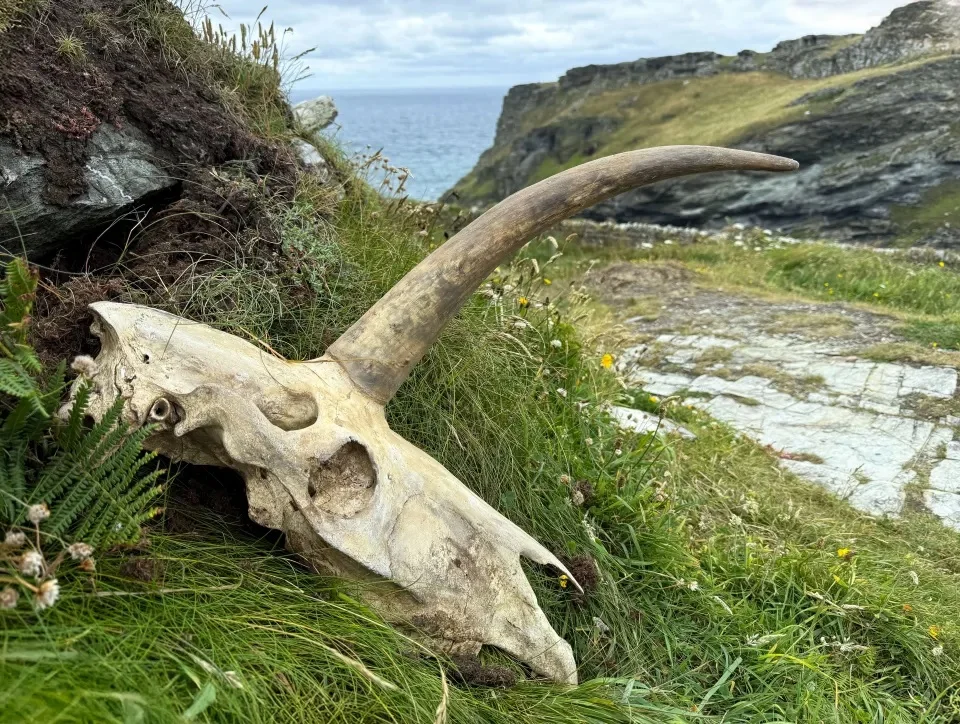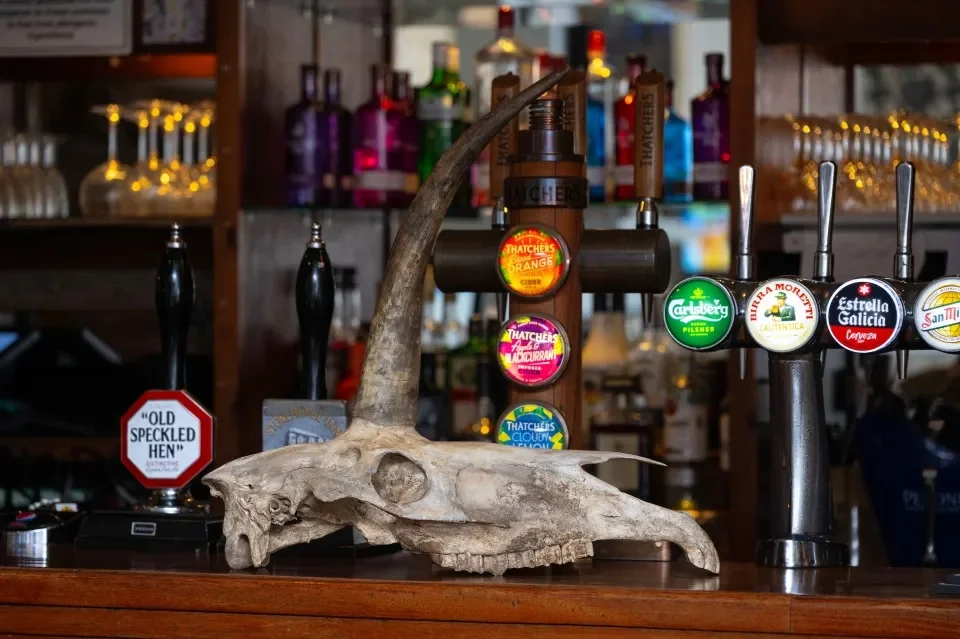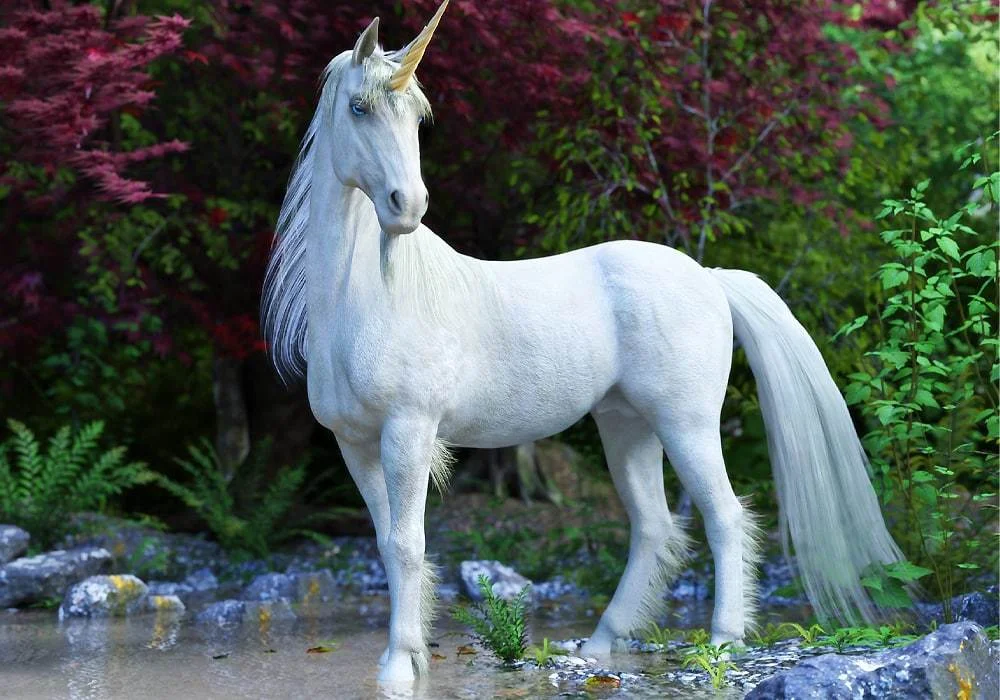Imagine stumbling upon a relic straight out of a fairy tale—a skull with a single horn, evoking the mythical unicorn, buried in the mystical lands of Cornwall, England. This is exactly what happened to Canadian tourist John Goodwin near Tintagel, the legendary site of King Arthur’s Camelot. The discovery of this enigmatic “unicorn skull” at St Nectan’s Glen has sparked fascination and debate, blending folklore with modern curiosity. Is it a freak of nature, a clever hoax, or a genuine artifact tied to Arthurian legend? Let’s dive into this captivating tale, exploring the discovery, its cultural significance, and the questions it raises.

The mysterious skull believed to be that of a mythical unicorn in Cornwall. (Source: ANDREW LLOYD)
A Magical Find in a Sacred Place
On a family holiday in Cornwall, 46-year-old Canadian plumber John Goodwin made a discovery that sounds like it belongs in a storybook. While exploring St Nectan’s Glen—a sacred waterfall area near Tintagel, steeped in spiritual and Arthurian lore—Goodwin noticed a horn-like protrusion sticking out from moss on a cliff edge. “I pulled it out and thought it must be a deer or something at first, but realized it only had one horn,” he told CornwallLive. When he freed the object, he found a heavy, ancient-looking skull with a single tusk in the center of its forehead, resembling the mythical unicorn. “It was real bone, heavy, and looked properly old,” Goodwin added, describing the eerie moment that made the hairs on his arm stand up.
Family vacation packages
The discovery’s location adds to its mystique. Tintagel is famed as the supposed birthplace of King Arthur, and St Nectan’s Glen is considered a sacred site, drawing thousands for its spiritual energy. The skull’s single horn immediately evoked the unicorn, a creature tied to Arthurian legend and revered as Scotland’s national animal, symbolizing purity and strength. Goodwin, in England to celebrate his grandparents’ 50th wedding anniversary, felt he had stumbled upon something extraordinary in a land rich with folklore.

Tourist John Goodwin traded the skull for free beer at the pub. (Source: ANDREW LLOYD)
However, not everyone was comfortable with the find. Goodwin’s grandmother felt uneasy, saying it “didn’t feel right to take it, like we’d disturbed something meant to be left alone.” This sense of unease hints at the deep cultural reverence for sacred sites like St Nectan’s Glen, where disturbing relics can feel like tampering with the mystical.
From Cornwall to Stonehenge Inn: The Skull’s Journey
Unsure of what to do with the skull, Goodwin first offered it to the Museum of Witchcraft and Magic near Boscastle, but they declined to accept it. As the family headed toward Stansted Airport for a vacation in Greece, they stopped at The Stonehenge Inn in Durrington, Wiltshire. There, Goodwin made an unusual trade. “I showed it to the staff at the pub, who offered me unlimited ale in return for it,” he told CornwallLive. “I decided that since I probably couldn’t take it through customs, I made the trade. I quite like Old Speckled Hen. The skull is still there now.”
Family vacation packages

This lighthearted exchange—swapping a potentially historic artifact for pints of beer—adds a quirky twist to the story, making it perfect for social media buzz. The Stonehenge Inn, located near the iconic Stonehenge monument, now holds the skull, which has become a local curiosity. The trade raises questions about the skull’s fate: will it be studied, displayed, or simply remain a pub oddity? The lack of official analysis leaves its origins unclear, fueling speculation about whether it’s a genuine anomaly or a staged hoax.
Myth, Hoax, or Natural Anomaly?
The unicorn skull has ignited debate among locals and online communities. In Arthurian legend, unicorns are potent symbols, often associated with Merlin and the mystical elements of Camelot. Some, like Goodwin’s grandmother, speculated it could be “Merlin’s unicorn,” tying it to Tintagel’s lore. However, experts quoted by CornwallLive have labeled it a “freak animal” rather than a magical artifact, suggesting it could be the skull of a deformed animal, such as a deer or goat, with a rare single-horn mutation. Similar real-world animals, like the narwhal (often called the “unicorn of the sea” for its single tusk) or certain antelope species with singular horn growths, provide plausible explanations.
Skeptics argue the skull could be a hoax, planted to capitalize on Cornwall’s rich mythology and attract tourists. Tintagel’s connection to King Arthur already draws visitors, and a “unicorn” find could amplify that allure. Yet, Goodwin’s account of the skull being embedded in the cliff, covered in moss, suggests it wasn’t recently placed. Without scientific analysis—such as carbon dating or DNA testing—the skull’s authenticity remains unverified, leaving room for both wonder and doubt. The Sun reported no official confirmation from local authorities or researchers, adding to the mystery.
On platforms like Facebook, where viral stories thrive, the unicorn skull’s blend of myth and reality is a perfect hook. It taps into humanity’s love for the unknown, blending the magic of folklore with the intrigue of a modern archaeological puzzle. Whether it’s a natural oddity or a cleverly crafted tale, the discovery invites us to dream of a world where unicorns might have roamed.
The discovery of a “unicorn skull” in Cornwall’s St Nectan’s Glen is a tale that captures the imagination, bridging ancient legend with modern mystery. John Goodwin’s find near Tintagel, a place steeped in Arthurian lore, raises tantalizing questions about its origins—could it be a freak of nature, a remnant of myth, or a clever hoax? From its sacred discovery site to its new home at The Stonehenge Inn, the skull’s journey is as fascinating as the debates it sparks. As we await scientific answers, this story reminds us why we’re drawn to the unknown, where the line between fact and fantasy blurs. Share this mystical tale with your friends, and let’s discuss: do you believe in the Cornwall unicorn, or is it just a pub tale fueled by ale?




